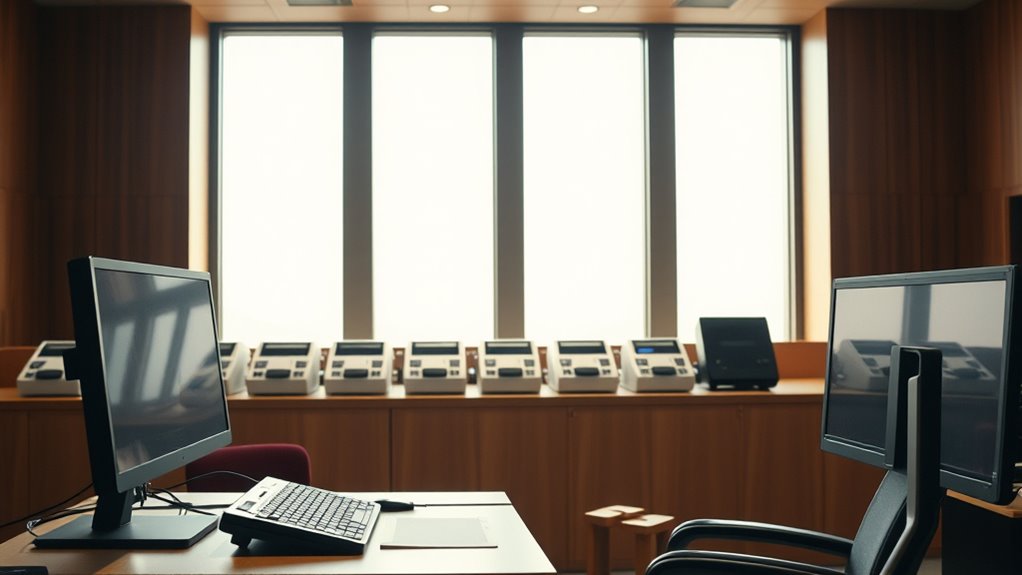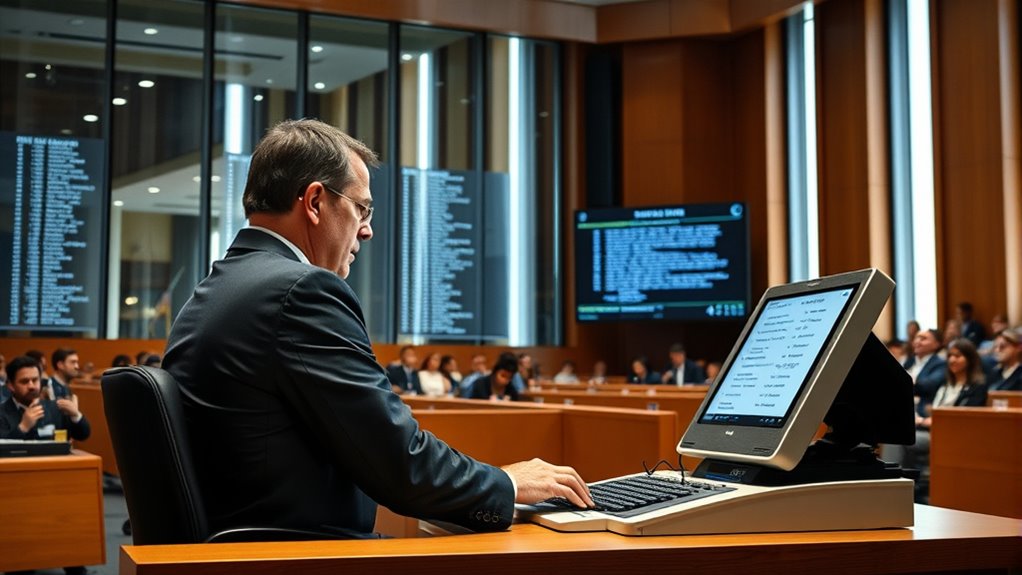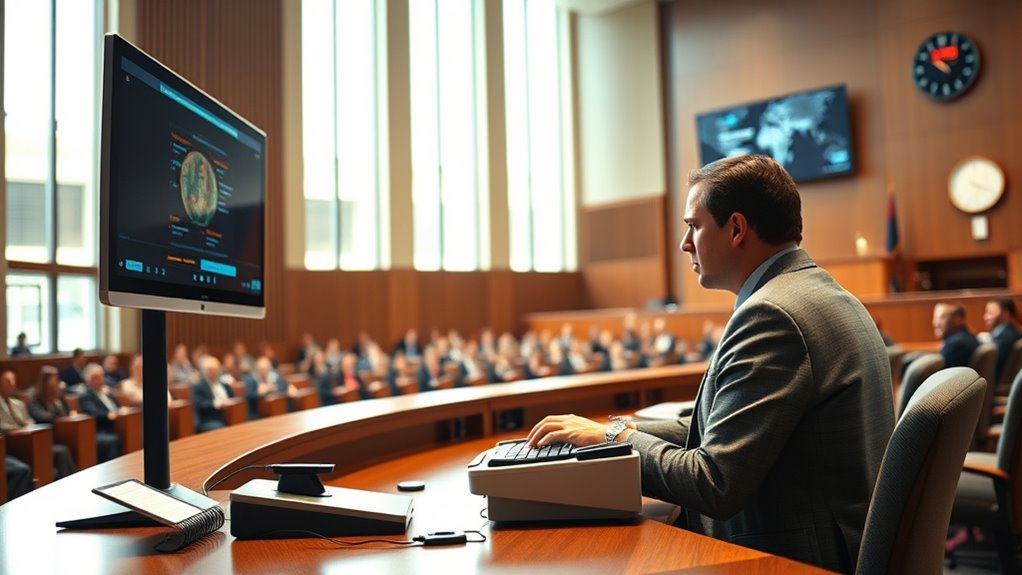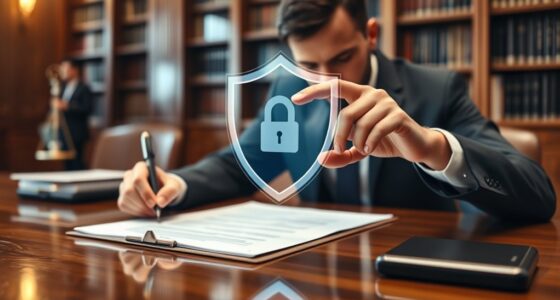In the digital age, court reporters are shifting from traditional stenography to advanced recording and transcription tools. With workforce shortages and aging stenographers, technology offers faster, more accurate, and secure transcripts through real-time audio, encryption, and AI-assisted review. This evolving landscape improves courtroom efficiency and guarantees legal records meet standards. If you want to explore how these innovations reshape court reporting and what it means for your role, keep exploring further.
Key Takeaways
- Digital court reporting utilizes audio recordings and real-time transcription technology, reducing reliance on traditional stenographers.
- Workforce decline and aging stenographers prompt a shift toward digital solutions for efficiency and cost savings.
- Legally admissible digital transcripts require high-quality audio, encryption, and adherence to certification standards.
- Training and certification programs now include digital reporting skills, blending traditional expertise with technological proficiency.
- The future of court reporting involves increased integration of AI, instant transcripts, and cross-sector applications for faster legal processes.
The Decline of Traditional Stenography Workforce

The traditional stenography workforce is rapidly shrinking, driven by several concerning trends. You’ll notice the number of stenographers in the U.S. has declined by 21% over the past decade, leaving only about 23,000. Enrollment in stenography schools has plummeted by 74%, and nearly half of these programs have closed. Most stenographers are 45 or older, signaling an impending wave of retirements and fewer new professionals entering the field. Despite their impressive speed of 225 words per minute, the workforce simply isn’t growing to meet demand. This decline creates significant challenges for courts and legal professionals, who rely on accurate transcripts. The shrinking pool of qualified stenographers threatens the stability and accessibility of court reporting services nationwide. Additionally, advancements in AI-powered virtual reality in e-learning and generative AI are beginning to offer alternative solutions for transcription and documentation tasks, which could further impact the stenography workforce in the coming years. As technological innovations continue to evolve, the need for traditional stenography may diminish even further, prompting a shift toward digital solutions. The integration of digital transcription technology is expected to accelerate, potentially replacing some traditional roles altogether.
Transitioning to Digital Court Reporting Technologies

As the traditional stenography workforce declines, courts and legal professionals are increasingly turning to digital court reporting technologies to fill the gap. You’re adopting tools like high-quality audio recorders, real-time transcription software, and encrypted platforms to guarantee accurate, timely records. Moving involves training on new equipment, understanding legal standards, and integrating digital workflows seamlessly. You’ll also need to stay updated on certification requirements for digital reporters and adapt to evolving regulations. Digital reporting offers efficiency, cost savings, and increased accessibility, making it a practical solution to workforce shortages. To succeed, you must embrace continuous learning, invest in reliable technology, and prioritize maintaining transcript integrity. Staying aware of AI security vulnerabilities helps ensure the confidentiality and reliability of digital transcripts. This change’s goal is to keep court processes running smoothly despite staffing challenges. Additionally, understanding industry trends and staying informed about emerging voice over technologies can give you a competitive edge in adapting to this digital shift. Recognizing the importance of Gold IRA options can also inspire confidence in securing long-term financial stability amidst these technological advancements. Developing a thorough understanding of digital evidence management systems can further streamline case handling and improve overall accuracy.
Benefits of Digital Methods in Courtrooms

Digital methods in courtrooms offer faster transcription turnaround, so you get your transcripts quickly and can proceed without delays. They are cost-effective solutions that reduce expenses compared to traditional stenography, making court reporting more accessible. Plus, digital tools enhance accuracy and security, ensuring your records are reliable and protected against tampering. Additionally, implementing advanced technology can streamline the workflow and improve overall efficiency in the courtroom, especially as courts adapt to changing legal procedures. Incorporating sound healing science techniques is also gaining interest for reducing stress and improving focus among court staff, contributing to a more effective judicial process. Furthermore, understanding Louisiana alimony laws can help court reporters accurately interpret legal documents related to financial support. Staying informed about regional divorce statistics can also assist court reporters in anticipating case types and preparing appropriately.
Faster Transcription Turnaround
Faster transcription turnaround has become a key advantage of digital court reporting, enabling legal teams to access accurate records almost immediately. Digital methods use real-time audio recording and instant transcription tools, considerably cutting delays. This rapid process allows you to review, annotate, and verify transcripts during proceedings or shortly after. The benefits include:
- Immediate availability of transcripts for review
- Reduced waiting time from days to hours
- Enhanced ability to address errors quickly
- Streamlined workflow for legal professionals
- Headphone compatibility ensures that audio can be monitored clearly during proceedings or recordings.
These features help you stay ahead in fast-paced cases, ensure timely case management, and improve overall efficiency. Digital reporting ensures you don’t have to wait long for critical information, keeping legal proceedings smooth and on schedule.
Cost-Effective Solutions
Implementing digital court reporting can considerably reduce costs for legal systems and organizations. You avoid expenses linked to stenographer salaries, overtime, and extensive training, as digital methods often require less specialized staffing. High-quality audio equipment and real-time transcription tools are more affordable than maintaining a large stenographer workforce, especially in areas facing shortages. Digital solutions also cut overhead by eliminating the need for physical stenotype machines and paper transcripts. Additionally, faster turnaround times mean less time spent on post-session editing and correction, saving staff hours and reducing delays. This efficiency translates into lower overall costs for courts and legal teams alike. Cost savings can be achieved through streamlined workflows and reduced resource expenditure. As a result, digital reporting offers a budget-friendly alternative that maintains quality and speeds up the legal process. Incorporating meditation practices into daily routines can further enhance focus and reduce stress among court reporters, improving overall performance and well-being. Furthermore, embracing digital technology can help address staffing shortages and improve overall productivity in court reporting. Adopting modern tools can also facilitate easier updates and integration with existing legal systems, making the transition smoother. Utilizing technological advancements can also contribute to more accurate and efficient transcription processes, further supporting cost-effectiveness.
Enhanced Accuracy and Security
Because digital court reporting combines advanced audio capture with real-time transcription, it particularly enhances accuracy and security in the courtroom. You benefit from multi-channel recordings that reduce errors and improve speaker identification, ensuring precise transcripts. Encrypted software protects sensitive data from unauthorized access, maintaining confidentiality. Digital methods also allow immediate review, annotation, and verification, streamlining the process and minimizing mistakes. Additionally, AI-driven tools help catch inconsistencies, further boosting accuracy. You can trust that digital reporting meets admissibility standards comparable to traditional stenography. Overall, these innovations provide a reliable, secure way to document proceedings, ensuring legal accuracy and safeguarding sensitive information. Data-driven strategies also help optimize workflow and resource allocation in digital court reporting.
Ensuring Accuracy and Reliability in Digital Transcripts

Ensuring your digital transcripts are both accurate and legally admissible is vital for maintaining trust and integrity in court proceedings. You need to implement precise recording techniques, use reliable software, and incorporate human oversight to catch errors. By doing so, you uphold the standards required for legal accuracy and guarantee transcripts stand up in court.
Maintaining Transcription Accuracy
Maintaining transcription accuracy in digital court reporting is crucial to uphold the integrity of legal proceedings. Your focus should be on implementing precise recording techniques and rigorous review processes. To guarantee accuracy, you can:
- Use high-quality audio equipment to capture clear sound
- Regularly verify speaker identification during proceedings
- Employ real-time review and correction features
- Follow strict protocols for encryption and data integrity
Keeping transcripts accurate depends on continuous attention to detail and timely verification. Digital tools can flag inconsistencies or errors for review, helping you catch mistakes early. Human oversight remains essential to interpret nuances, context, and legal terminology. Combining technology with diligent review ensures transcripts are reliable, precise, and legally sound.
Ensuring Legal Admissibility
High-quality digital transcripts can be challenged in court if their accuracy and reliability are not properly validated. To guarantee legal admissibility, you must follow strict standards for recording, storage, and verification. Use encrypted, tamper-proof software to prevent alterations and maintain an audit trail. Regularly verify transcripts against audio recordings with human oversight to catch errors and clarify context. Proper certification and adherence to industry standards reassure courts of your methods’ integrity. Consistent documentation of procedures and validation processes further strengthen admissibility. When you combine technology with diligent review, you demonstrate that your transcripts are trustworthy, accurate, and legally sound. This approach ensures your digital records stand up to scrutiny and uphold the justice system’s standards.
Regulatory Developments and Industry Standards

As digital court reporting becomes more prevalent, regulatory developments are shaping how industry standards evolve to accommodate new methods. You’ll see efforts to update certifications, ensuring both stenographers and digital reporters meet consistent quality benchmarks. Legislation is increasingly recognizing digital transcripts as admissible, provided they meet accuracy and security standards. Industry groups advocate for flexible regulations that remove barriers for digital reporting adoption. You should also expect stricter guidelines on data encryption, speaker identification, and real-time verification.
Digital court reporting standards are evolving with new certifications, security measures, and legal recognition.
- Certification standards expanding to include digital reporting
- Regulations emphasizing transcript accuracy and security
- Recognition of digital transcripts as legally valid
- Ongoing updates to accommodate technological advancements
Training and Certification for Digital and Traditional Reporters

To stay competitive in today’s legal environment, you need proper training and certification that reflect both traditional and digital reporting methods. As standards evolve, you must adapt your skills through ongoing education to guarantee accuracy and compliance. Continuous learning is essential to meet industry demands and maintain your professional credibility.
Certification Standards Evolution
The evolution of certification standards in court reporting reflects the growing need to adapt training and credentialing processes for both traditional stenographers and digital reporters. As technology advances, certification bodies are updating requirements to guarantee competency across methods. You’ll see standards that emphasize technical proficiency, ethical practices, and transcript accuracy. Certifications now often include digital tools, audio capture techniques, and real-time transcription skills. This shift encourages a unified approach, recognizing the importance of versatility in the workforce.
- Incorporate digital reporting skills into certification criteria
- Emphasize ongoing education and tech adaptation
- Guarantee standards meet legal admissibility and privacy laws
- Promote a unified credentialing system for all reporting methods
Digital Reporting Training
Certification standards in court reporting now prioritize digital skills alongside traditional stenography, reflecting the evolving landscape of the industry. To stay competitive, you need training that covers audio recording, real-time transcription, and ethical standards for digital tools. Many programs combine classroom instruction with hands-on experience in both methods. Here’s a quick overview:
| Skill Focus | Training Focus | Certification Type |
|---|---|---|
| Stenographic Skills | Keyboard shortcuts, speed tests | Traditional Certification |
| Digital Audio Tech | Recording devices, encryption | Digital Certification |
| Transcription Accuracy | Error correction, review methods | Both certifications |
| Ethical Standards | Confidentiality, neutrality | Universal Standards |
This training prepares you to adapt, meet industry demands, and uphold legal standards effectively.
Continuing Education Importance
As the court reporting industry evolves, ongoing education becomes essential for professionals to stay current with technological advances and maintain high standards. Keeping your skills sharp guarantees you remain competitive and reliable, whether using traditional stenography or digital tools. Continuous learning helps you adapt to new software, audio capture techniques, and legal standards. Staying certified and enrolled in refresher courses demonstrates your commitment to accuracy and professionalism. Consider these key areas:
- Updates in digital recording technology
- Certification renewal requirements
- Legal and ethical standards
- Skills development in real-time transcription
The Growing Demand for Real-Time Transcription Services

Demand for real-time transcription services is skyrocketing across legal, medical, and corporate sectors as organizations seek immediate, accurate records of ongoing proceedings. You need transcripts delivered instantly to make timely decisions, ensure transparency, and meet strict deadlines. Advances in AI and digital reporting tools have made real-time transcription more reliable, reducing delays considerably. Legal teams rely on instant access to spoken words for cross-examination and case strategy, while medical professionals use real-time notes for patient care. Corporate meetings and negotiations demand immediate documentation for clarity and compliance. This surge in demand pushes industry standards higher, requiring reporters to adapt quickly and embrace new technologies. As a result, the need for trained professionals skilled in real-time transcription grows, shaping the future of court reporting and recordkeeping.
Impact of Technology on Courtroom Efficiency and Justice

Advancements in technology are transforming how courts operate, markedly boosting efficiency and access to justice. You benefit from faster case processing, reduced delays, and more reliable records. Digital tools streamline courtroom procedures, enabling real-time transcription and immediate review. This means less waiting for transcripts and quicker case resolutions. Technology also improves transparency by providing secure, accessible records for all parties.
Technology enhances court efficiency with faster processing, real-time transcription, and secure, accessible records for all parties.
- Faster turnaround times for transcripts
- Improved accuracy with multi-channel recording
- Easier access to case records and transcripts
- Enhanced courtroom security with encrypted software
These innovations help courts handle increasing caseloads and serve justice more effectively. As a result, technology reduces bottlenecks, minimizes errors, and supports fairer, more transparent proceedings.
Addressing Workforce Shortages Through Innovation

To effectively combat the persistent court reporting workforce shortage, courts and legal organizations are turning to innovative solutions that blend technology with traditional practices. Digital court reporting offers a cost-effective, scalable alternative that reduces reliance on declining stenographer numbers. High-quality audio recording, real-time transcription, and speaker identification help improve accuracy and speed while expanding access in rural and underserved areas. Training programs now incorporate audio capture, legal procedures, and ethical standards to prepare digital reporters for the demands of the profession. Certification processes are evolving to recognize both stenographic and digital methods, ensuring quality and legal admissibility. By embracing these innovations, you can help maintain timely, accurate transcripts and support the justice system’s integrity amid workforce shortages.
Future Perspectives: Collaboration Between Stenographers and Digital Reporters

As the industry navigates the ongoing workforce shortages, integrating traditional stenography with digital reporting emerges as a practical solution. You’ll find that combining these methods enhances reliability, speeds up transcript delivery, and broadens access. Collaboration can involve training stenographers in digital tools, using digital recordings to supplement stenotype, and adopting hybrid workflows. This approach allows you to:
- Leverage the speed of digital transcription for quick turnaround
- Maintain accuracy through human oversight and AI-assisted review
- Expand coverage to rural and underserved areas
- Ensure transcripts meet legal standards and admissibility requirements
Frequently Asked Questions
How Do Digital Court Reporters Handle Complex Legal Terminology?
Digital court reporters handle complex legal terminology by using advanced audio recording tools combined with real-time annotation software, which helps capture precise language. You’ll rely on specialized training to familiarize yourself with legal terms and procedures, ensuring accurate transcription. Additionally, human oversight remains essential, allowing you to review, verify, and clarify terminology as needed, maintaining the transcript’s legal integrity and ensuring all details are accurately documented.
What Security Measures Protect Digital Transcripts From Tampering?
You should know that 96% of industry respondents agree accuracy is key, so protecting digital transcripts is essential. You can implement encryption, secure login credentials, and audit trails to prevent tampering. Regular software updates, multi-factor authentication, and restricted access control help guarantee integrity. These measures make it difficult for unauthorized users to alter transcripts, maintaining the trustworthiness and legal admissibility of digital records.
Can Digital Reporting Replace Stenographers in High-Profile Cases?
Digital reporting can replace stenographers in high-profile cases when it’s properly implemented. You need reliable audio capture, real-time transcription, and strict security measures to guarantee accuracy and integrity. As long as human oversight, verification, and adherence to legal standards are maintained, digital methods can match traditional stenography. Embracing technology helps prevent delays, reduce costs, and keep up with modern courtroom demands, making digital reporting a viable option for high-stakes proceedings.
How Do Courts Ensure Digital Transcripts Meet Legal Admissibility Standards?
Courts guarantee digital transcripts meet legal admissibility standards by implementing strict protocols, including encrypted recording software, real-time verification, and maintaining detailed audit trails. You should use certified digital reporters trained in legal procedures, adhere to jurisdictional regulations, and follow established standards for accuracy and integrity. Regular audits and human oversight help verify transcript correctness, ensuring the digital record is as reliable and admissible as traditional stenographic transcripts.
What Are the Costs Associated With Transitioning to Digital Court Reporting?
You’ll find that moving to digital court reporting involves upfront costs like purchasing high-quality audio equipment, encryption software, and training. These investments guarantee accuracy, security, and compliance with legal standards. While initial expenses can be significant, they offset long-term savings from reduced transcription times and fewer errors. Embracing digital tools ultimately streamlines operations, making the cost worthwhile as you support faster, more reliable court proceedings.
Conclusion
As you navigate the evolving courtroom landscape, keep in mind that digital court reporting is growing rapidly—by 2025, the industry is expected to reach $3.2 billion. This shift offers increased efficiency, real-time transcripts, and improved accuracy. Embracing these innovations guarantees you stay ahead in justice delivery, blending traditional skills with new technology. The future holds exciting collaboration opportunities between stenographers and digital reporters, shaping a more effective and accessible legal process for everyone.









